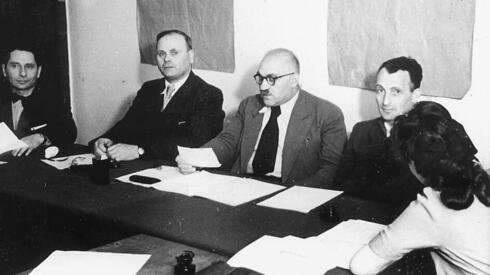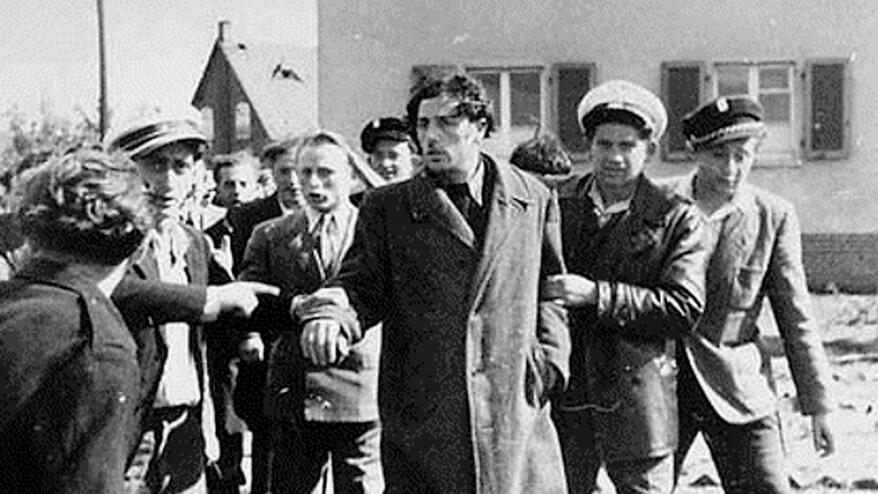Few nations emerged from cursed places—where, in the searing words of K. Tzetnik, “people breathed according to different laws of nature”—without descending into civil war that might have finalized their destruction. In most cases, the aftermath of devastation became a time for settling internal scores: between collaborators and their victims, between those who betrayed their fellow Jews and those who remained loyal under the harshest conditions.
To some extent, this reckoning unfolded in the young State of Israel. Many sought to bring to justice Jews who had collaborated with the Nazis—primarily in administrative or policing roles, such as members of the Judenräte, Jewish police, or camp officials like block heads and kapos. It was in this context that the 1950 Law for the Punishment of Nazis and Their Accomplices was enacted. But as lawmakers acknowledged a decade before the Eichmann trial, the law was largely intended to address Jewish collaborators: “The Nazis will not be coming here anytime soon,” one MP admitted.
A significant majority in the Knesset supported the prosecution of their own people, even those who had not chosen their roles but had been forced into them. MK Israel Bar-Yehuda declared, “Every member of a Judenrat who sat there… is a criminal, an accomplice of the Nazis… even if he acted out of that primal human instinct to survive. There may be mitigating circumstances, but criminal responsibility remains.” Even Adam Czerniaków, chairman of the Warsaw Ghetto Judenrat—who took his own life in 1942 rather than comply with Nazi deportation orders—was not spared: “Had he not committed suicide,” Bar-Yehuda said, “he should have stood trial for helping send tens of thousands of Jews to their deaths.”
Only a few lawmakers dared to defend the so-called “traitors.” The law itself deviated from basic principles of criminal justice, applying retroactively to acts committed outside Israeli jurisdiction and waiving standard rules of evidence. All this was justified to send a message: Jews must never again collaborate, should catastrophe strike once more. Roughly 40 trials were held against Jews suspected of collaborating; in one case, a death sentence was handed down to kapo Yechezkel Ingster, later commuted to ten years in prison.
On the eve of Holocaust Remembrance Day, it is worth recalling the extraordinary story of how Holocaust survivors themselves judged suspected collaborators—before the State of Israel even existed. These grassroots proceedings occurred in the immediate aftermath of World War II, in the displaced persons (DP) camps where survivors found themselves, thrown together with no choice.
Dr. Rivka Brot, a legal scholar at Tel Aviv University and author of the Gray Zone: Collaboration in the Israeli Courtroom, has uncovered this remarkable chapter in her groundbreaking research. These were, in the words of Primo Levi, “beaten, broken, submissive human fragments.” Yet somehow, they established from nothing a functioning judicial system—without laws, enforcement powers, or international legitimacy. This system held hundreds of trials across some 100 DP camps in the American-occupied zone of Germany, which had become a magnet for Jewish survivors from across shattered Europe.
“This is truly a phenomenon we can be proud of,” says Brot, who is now writing a second book on this legal system. “But we must remember that all of Europe put collaborators on trial.” Still, the DP Jews weren’t states—they had no institutions, no power. “Exactly,” she says. “That’s what makes it so historically and legally fascinating. Here was a group of people who had undergone dehumanization, torture, and genocide, who lacked any state protection, and yet they created a legal system. It was beautifully articulated and genuinely operational. What excited me was this: a community with no past and no future refusing to wallow in ruin, choosing instead to rebuild, with law as part of that reconstruction.”
So how did this system emerge?
“First, it’s important to know that DPs weren’t only Jews—there were Poles, Ukrainians, and others,” Brot explains. These individuals, having lost their homes and unable to return, were defined by the U.S. Army as displaced. At first, Jews were housed with other DPs, but due to frequent violent incidents, they were eventually moved to Jewish-only camps. The Jewish leadership in these camps had a dual mission: to transform the survivors from helpless victims into active agents and to rebuild a destroyed sense of community and belonging.
Survivors saw themselves as a vanguard of the Jewish people—an elite within the chosen nation—tasked with the revival of Jewish life. This included setting social boundaries: who belonged and who did not. Holding collaborators accountable became part of defining that collective identity.
These trials unfolded as survivors, now thrown back together in camps, faced those they considered their oppressors. These encounters often sparked overwhelming emotion—and sometimes violence. Camp leaders sought to curb such chaos by shifting the issue from the social to the judicial realm, believing that a legal process, seen as rational, could better manage these complex cases.
Each camp established a legal department and a court to maintain order and prosecute suspected collaborators. Above them all stood a central system, including a special tribunal in Munich—the “Rehabilitation Court”—which focused solely on trying Jews suspected of collaboration.
Did these courts turn to Jewish religious law for guidance?
“No,” says Brot. “The most striking aspect of this legal system was its secular nature. There were rabbinical courts, mainly dealing with issues like agunot (women whose husbands were missing and could not remarry), but the criminal courts were entirely secular—a major innovation. Another novelty was the complete independence of the DP courts, unlike other institutions influenced by emissaries from Mandatory Palestine or the Jewish Agency. The legal codes and procedures were created by the community itself.”
This autonomy imbued the courts with powerful symbolism. Jews could now resolve disputes among themselves, on German soil, without relying on foreign legal systems.
No wonder some experienced entering these courts as a kind of spiritual elevation. Dr. Shlomo Ornstein, a prosecutor at the Landsberg camp court, wrote: “With trembling heart, my foot stepped across the threshold of the first Jewish courtroom in the American zone. I felt an inner fire I hadn’t known in years as I joined the bench of three Jewish judges.”
Interestingly, none of the codes explicitly defined collaboration as a crime. “They didn’t need to,” Brot says. “It was understood. It didn’t need a clause.”
Despite the camp conditions, these were not show trials. Proceedings were highly formal: indictments were drawn up, witnesses called, judges, prosecutors, and defense attorneys appointed—all from within the camp. Hearings were public, and the audience sometimes erupted into applause when a defendant was convicted, or shouted at them. Judges were elected democratically, and though most lacked legal training, each panel was required to have a legally trained presiding judge.
What punishments could they impose?
“Camps imposed prison sentences, fines, and social penalties—loss of privileges, forced labor, expulsion from the camp. In one case, a defendant was stripped of their right to receive cigarettes.”
Were there acquittals?
“Of course. That’s another key point: these trials followed proper procedure. People were acquitted if evidence didn’t support conviction. It was in these courts that survivors first spoke of ‘a good kapo’ or a ‘decent Jewish policeman’—concepts long absent from broader Jewish discourse.”
These trials functioned remarkably well despite minimal enforcement. A defendant could walk away at any time. “That did happen,” Brot admits. One example was Herbert Jules, convicted in absentia of betraying the Jewish people. He was branded a traitor and expelled from the Jewish collective, reserved for the most sadistic and violent offenders. He never appeared at his trial, having already fled.
Because the Rehabilitation Court began operating only in 1948—by which time immigration from the camps had begun—defendants and witnesses often left Germany before proceedings. To combat this, the Jewish leadership asked the Jewish Agency and the Joint Distribution Committee not to assist with emigration for wanted individuals.
Why not simply hand suspects over to U.S. military courts?
“There was a deep ethos: Jews don’t hand over other Jews to outside authorities. Collaboration was seen as an internal Jewish issue.”
The establishment of the Rehabilitation Court was prompted by American opposition to imprisonment by camp courts, which lacked legal authority to issue such sentences. The court, inaugurated in March 1948, handled only one type of case—collaboration—and tried about 300 individuals by 1950. Punishments included bans from public roles, expulsion, or referrals to U.S. authorities. The harshest sentence was “expulsion from the Jewish people.”
Remarkably, indictments weren’t filed in the name of individual victims but by “the Chosen People.” The issue wasn’t personal harm—it was a collective betrayal. As such, the offense was defined as “acts harmful to the Jewish people.”
When comparing these rulings to those handed down in early Israeli courts, one finds a striking contrast: survivors in the DP camps were often more empathetic toward collaborators than Israeli judges. “I wouldn’t call it leniency,” Brot says. “It was a rare depth of understanding for Jewish behavior during the Holocaust—something Israeli judges largely lacked. Israel was focused on nation-building and sought narratives of heroism. Collaborators, seen as betrayers, didn’t fit that mold.”
As the State of Israel rose, the DP camps emptied, and the legal system vanished. During Knesset debates over the 1950 law, the camp courts were never mentioned. It's as if Israel invented the prosecution of collaborators—erasing the memory of what survivors had already accomplished.
But those early courts had understood something profound—what Oscar Wilde once wrote: “Only the very brave seek justice; the rest of humanity seeks mercy.”




